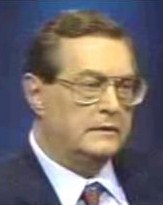Difference between revisions of "Victor Marchetti"
(Expand) |
(image) |
||
| Line 3: | Line 3: | ||
|spartacus=http://spartacus-educational.com/JFKmarchetti.htm | |spartacus=http://spartacus-educational.com/JFKmarchetti.htm | ||
|namebase=http:// www.namebase.org/main4/Victor-L-Marchetti.html | |namebase=http:// www.namebase.org/main4/Victor-L-Marchetti.html | ||
| + | |image=Victor Marchetti.jpg | ||
|birth_date=December 23, 1929 | |birth_date=December 23, 1929 | ||
|constitutes=spook, author, whistleblower | |constitutes=spook, author, whistleblower | ||
Revision as of 17:24, 30 November 2016
(spook, author, whistleblower) | |
|---|---|
 | |
| Born | December 23, 1929 |
Victor Marchetti, told Harrison Edward Livingstone and Steve Parks of the Baltimore Sun that he thought that Paisley was killed because of fears that he was "about to blow the whistle" to the House Select Committee on Assassinations.
Career
As an American soldier, Victor Marchetti was recruited into the intelligence agencies in 1952 during the Cold War to spy on East Germany. He applied to join the CIA and did so in 1955. He soon became a leading CIA expert on Third World aid, with a focus on USSR military supplies to Cuba.[1] In 1966, Marchetti was promoted to the office of special assistant to the Chief of Planning, Programming, and Budgeting, and special assistant to [CIA Director]] Richard Helms. He also worked as a special assistant to the Deputy Director of the Central Intelligence Agency. He resigned, disillusioned, in 1969.[1]
Publications
Victor Marchetti with John D. Marks wrote CIA and the Cult of Intelligence, arguing that reform was needed in the CIA. The manuscript was completed in 1973. CIA officials read the manuscript and told Marchetti and Marks that they had to remove 399 passages, nearly a fifth of the book. After long negotiations the CIA yielded on 171 items, leaving 168 censored passages. The publisher, Alfred A. Knopf, decided to go ahead and publish the book with blanks for those passages, and with the sections that the CIA had originally cut but then restored printed in boldface.[2] This was perhaps the first book to use blacking out to reveal the extent of its censorship in this way.
He has continued to publish various articles critical of the CIA.[1]